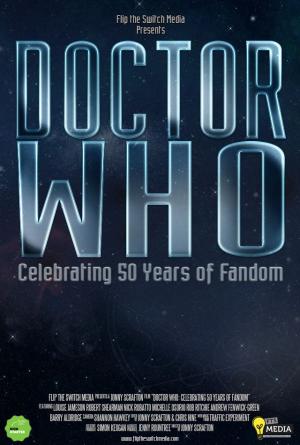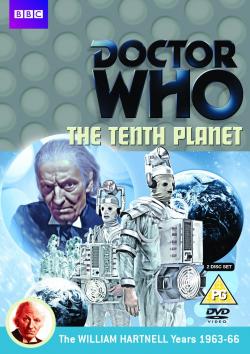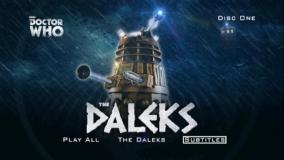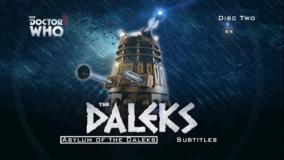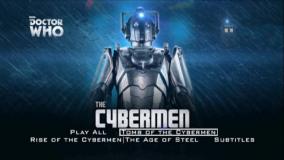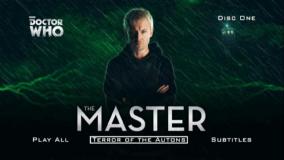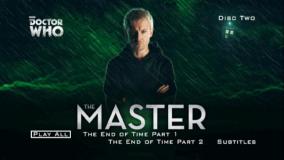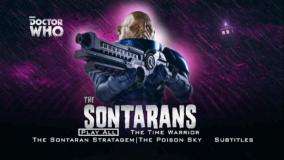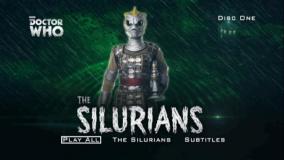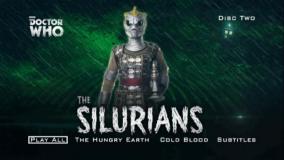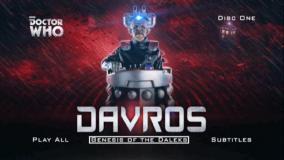Shada (DVD/Blu-Ray/Steelbook)
Shada
Written by: Douglas Adams
Directed by: Pennant Roberts, Charles Norton
Produced by: Graham Williams
Cast
Tom Baker (The Doctor), Lalla Ward (Romana), David Brierly (K9), Christopher Neame (Skagra), Daniel Hill (Chris Parsons), Denis Carey (Professor Chronotis), Victoria Burgoyne (Clare Knightley), Gerald Campion (Wilkin), Shirley Dixon (Ship), Derek Pollitt (Caldera), James Coombes (voice of the Kraags), John Hallet (Police Constable), David Strong (Man in Car)
Cover Art: Lee Binding (DVD, Blu-Ray), Adrian Salmon (Steelbook)
Originally Released: November 2017
Shada Reborn
Quite possibly a record-breaking candidate for the longest filming period for a single script, Shada bridges two millennia – from 1979 to 2017 – and represents a heroic effort to finally plug one of the most egregious gaps in the Doctor Who canon.
In a way, Shada mirrors the antagonist of that other great Douglas Adams story, City of Death. Just as Scaraoth is shattered into dozens of versions of himself across the centuries, the industrial action that stymied the original production of the serial saw it fractured into a number of variants and doppelgangers. Most famously, Adams decided the root concepts and ideas behind his final Doctor Who script were too good to waste and they found their way into his Doctorless novel Dirk Gently’s Holistic Detective Agency. In 1992, a rough edit of the surviving footage was patched together with exposition from Tom Baker and some unsympathetic synthesizer music. Later again, an animated incarnation saw Paul McGann’s Eighth Doctor reunite with Romana and K9 and a new supporting cast to cure a nagging feeling of something undone in Cambridge 1979.
But this Shada is very much the real deal. The entire surviving cast have been reunited to record the missing dialogue, the missing sequences have been animated where appropriate, though brand new models and have constructed and filmed by the Model Unit to act as inserts in the live action scenes, and a brand new score by Mark Ayers is constructed like an act of musical archaeology to recreate the instruments, methods and style of 1970s legend Dudley Simpson. It can never by Shada as it would have been, but it by far lays the strongest claim to being the definitive article.
As with any such project, the team had to make creative decisions and not everyone will agree with all of them. For instance, with Denis Carey (Professor Chronotis) and David Brierly (K9) having died since their original contribution a couple of minor scenes requiring them are left unanimated, while others have their presence reduced to lines which could be reproduced from other recordings of the actors. While some no doubt may have preferred soundalikes to be used to make as complete a version as possible, it’s a sensitive decision and highlights that, in fact, the missing moments were largely padding anyway. Similarly, but much more controversially, is the decision to assemble Shada as a 138 minute film rather than as six episodes. (It even has - steady yourself - a pre-titles sequence). This will go against every instinct of many long term fans, still sore from VHS cassettes of hacked down stories and the fight to get episodic releases. But in this case it seems to work. Watched in one sitting it makes for a breezy, fun, adventure – yet the way the story is paced would have seen the episodic version with a curiously uneventful Part One and a number of extremely undramatic cliffhangers (only the midway point would have given us something as genuinely brilliant as “Dead men require no oxygen”). For me, the only genuinely poor decision is to seize on the existence of the original K9 prop, some original wall panels from the 1979 set, and the surviving (bottom) half of an original Kraag monster costume to recreate a few shots of K9 fighting a Kraag. I appreciate the sentiment behind it, but the fact the surviving bit of set to squeeze them into is so small, and the Kraag only visible from the waist down, makes for a weirdly, and unintentionally silly, looking moment that takes you out of the flow of the story more than the switches to animation do.
Few would argue, though against the decision to bring in Martin Gergharty and Adrian Salmon to do design work for the animation. Not only are they brilliant in their own right, creating clear lined, loyal yet character-filled, interpretations of the cast in warm, friendly colours, it also helps smooth over the slightly stilted, flash style – the characters may not feel like they have a full range of human movement, but the presence of Gergharty’s art, so familiar to the readership of Doctor Who Magazine, makes it feel almost like panels from the beloved DWM comic strip brought to life.
Shada Reviewed
But has all this effort simply been an ultimate exercise in obsessive, fannish, completeness? Are we seeing the resurrection of a poor story just because it’s there to be done, or the completion of a classic in its own right? In short – is Shada actually any good?
As it happens, Shada is brilliant jewel to add to Doctor Who’s crown if one, like all the most spectacular diamonds, not without its flaws. One the wittiest of Who scripts, and certainly with one of the most fascinating premises, at six parts it’s basically City of Death with extra portions. Famously, one of the script’s biggest critics is its own author – written, as it was, at a point when Douglas Adams was juggling several different projects and deadlines and pouring his greatest effort into his own personal work rather than Doctor Who. Considering that a billion years from now, stuck in the glovebox of an interplanetary roadster, the fruits of that rival project may be the last sign of the human race’s existence, it would be churlish to complain about that but still, Adams is being ungenerous about the serial.
In almost every way, this is the fullest encapsulation of the latter half Tom Baker years. Tom himself exudes the same sort of relaxed charm, peppered with moments of total nonsense that marked City of Death while Lalla Ward has never seemed more possessed of an unearthly beauty. All of their scenes together are a joy and something as simple as them going boating, or visiting an old friend in his rooms for tea is all stuff I could watch hours of, even without any alien menaces showing up. And the alien menace that does show up is stupendous – possibly the most unbelievable thing about the whole story is the revelation on the commentary track that the people in the background of Cambridge genuinely ignored Christopher Neame in his outrageous hat and slowing silver cape as if he was an everyday sight. But the massively fun campness of Neame’s character Skagra is balanced by the imaginative and typically Adamsian plot the villain has hatched. Skagra is unusually preoccupied with the heat death of the universe in several billion years’ time and obsessed with stopping it. Like solving the central question of Life, the Universe, and Everything the main stumbling block to finding the answer is processing power – so he’s going to absorb every mind in the universe into one great gestalt entity, so that every being in creation is simply a conduit for finding a way to save it without the petty distractions of life. In a way, it’s Douglas Adams inventing cloud computing thirty years early and typical of the scientific verve and imagination he brought to everything he wrote. (Tellingly, a year later his replacement would also craft a story about forestalling the heat death of the universe but, while propounding the superiority of ‘hard science’, would solve it by inventing some space wizards who use magic words to make it go away).There are undoubtedly flaws, mostly as we race towards the end with the mounting sense of a script with the ink still wet and no time for afterthought or final drafts. Chris Parsons is probably the best of the solid young everymen Doctor Who has ever featured, and pitched perfectly by Daniel Hall, yet despite early episodes spending more time of introducing and building on his character, he gets lost in the shuffle of the climax. There’s even a dramatic scene of Chris making a vital deduction and racing out to save the day, only for Adams to be plainly unable to think of anything to give him to do once he gets there (a problem Gareth Roberts ingeniously solved in his 2012 novelization but which, presumably for purity’s sake, the producers here don’t take the opportunity to steal). Meanwhile, the Kraag outfits are really quite poor, even for the era that gave us the Nimon and the Mandrel, and a lot of the location film work in Cambridge feels rather loose and in need of a tighter edit.Yet, there’s an inescapable magic to Shada that goes well beyond its status as a mythical ‘lost’ story, and had it been completed in 1979 it would still have been regarded as one of the highpoints of Season Seventeen.
Extras
This release comes with a full set of extras the complement the story perfectly. A commentary orchestrated by the unsinkable Toby Hadoke on less funding than the bus fare into town sees him interview Neame and Hall about their experiences during filming, and Gergharty and animator Ann Marie Walsh about the pressures and effort involved in creating the project against incredibly tight deadlines. Taken Out of Time interviews many of the those involved in front of and behind the cameras on the original production to build a picture of exactly how it came to abandoned in the first place. Strike! Strike! Strike! uses contributions from those involved in industrial relations at the time to help explain exactly how the unions of 1970s television came to be so powerful, and give a potted history of their rise and fall through the lens of how industrial action had impacted Doctor Who over the decades both negatively (when it was at the BBC) and positively (when it was arch rival ITV left showing blank screens opposite the Doctor’s adventures). Both of these are proper, half hour documentaries that tell a story of their own almost as compelling as Shada itself.
There’s also fascinating Studio Sesssions - 1979, showing the working methods of the cast and crew in-studio as the cameras roll between takes. Most fun of all is are the Dialogue Sessions – in which we get to see Tom Baker and Daniel Hall record their contributions for the animation, with all Tom’s uproarious ad libs and suggestions for improvements to the script intact. The extras are rounded out with the video of the Model Unit filming of Skagra’s space station and ship, as well as the TARDIS model, new footage taken of Daniel Hall and Tom Baker’s stand-in as reference for animation, photo galleries, as well as the obligatory Now and Then tour of what the Cambridge locatoins look like three decades on. ROM content even includes a full set of scripts, storyboards, and the 1979 Doctor Who Annual (if, rather bizarrely, packed as 56 separate image files).The Steelbook release goes even further to try and lay claim to the definitive Shada package – with a third disc containing the 1992 reconstruction and the 2003 Paul McGann web animation adaptation (remastered for viewing on TV screens rather than computer monitors). About the only thing not included is the novelization.
Presentation and Packaging
The DVD version has a slightly astonishing error where the coding that tells a television to display it as 16:9 or 4:3 is messed up – meaning that if watched on a 4:3 television the image will appear in the centre of the screen, with black bars on all sides – top, bottom, left and right. On a modern 16:9 television it displays the picture correctly (with bars on left and right as this is archive television intended as 4:3) but even then some resolution is lost as the image is basically being blown up to fit. That said, you’d be hard pressed to actually notice the lower resolution on viewing the DVD and it probably still looks better than it would have done on the average 1970s domestic television. All the same it’s disappointing to see such hard work by so many involved obviously handed off to someone much less fastidious at the eleventh hour for authoring the DVDs. It should be stressed, however, that the Blu-Ray and Steelbook don’t share this flaw so, if it’s going to bother you, those are the routes to take.
The cover art, some may remember, was the cause of a bit of a social media flap last year when Clayton Hickman’s distinctive and unusual scarf patterned cover was ditched at the comparative last minute. In the final result, Lee Binding’s replacement is… fine, if a little bland and stilted seeming, probably as a result of the tight deadlines under which it was done. Strangely, a vestige of Hickman’s original design lingers on in the insert booklet. “Bland” is not something anyone could accuse the Steelbook art of. Undoubtedly DWM’s most marmite love-him-or-hate-him artists, Adrian Salmon provides a cover piece in his distinctive, angular, impressionistic style. Personally, I love him.
A thread long dangling frustratingly at the corner of Doctor Who history, Shada is reborn by a massive and dedicated effort by a hugely talented team to reveal it as an all time classic mix of Douglas Adams’ trademark whimsy and intelligence. Handsomely accompanied by a great set of extras and marred only by some inexplicable technical sloppiness, this is a must for any collection. But one, perhaps, to get on Blu-Ray if possible.
